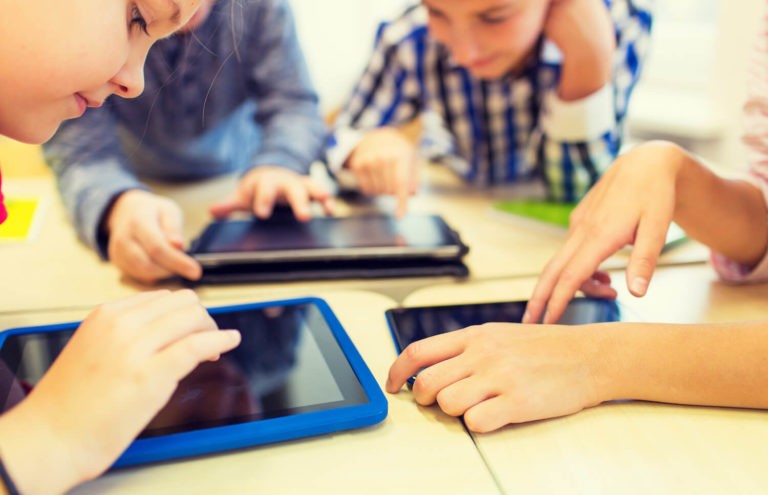The impact that COVID-19 has had on our society is both undeniable and immeasurable. The field of education has certainly changed considerably as a result of this pandemic. In fact, distance learning is becoming the new normal for many of our students. With distance learning comes the need for students to experience a lot more screen time than what they may have been accustomed to in the traditional face-to-face school setting. Although there are many benefits to this increased amount of screen time for students, too much screen time may become problematic for them.
How Much Screen Time is Too Much?
Many experts are saying that too much screen time may have effects on brain development. Studies have shown that students who spent more than two hours a day using screens scored lower on language and thinking tests (Adolescent Brain Cognitive Development, 2018). It has also been said that students who spend more than seven hours a day may experience thinning of the brain’s cortex. The brain’s cortex is the part of the brain that is related to reasoning skills and critical thinking.
Students who spend more time on the screen are less likely to want to engage in physical activities and social interaction in a face-to-face setting. This creates a concern for students who become accustomed to distance learning and will need to transition back into the face-to-face format of schools.
Prior to COVID-19, the American Academy of Pediatrics recommends that children between the ages of two and eighteen years old limit screen time to only two hours per day. They have recently made new recommendations that take into consideration that technology has been integrated into the daily lives of school-aged children. They recommend avoiding the use of a ‘one size fits all ‘approach to the screen time for children and that screen time is monitored and limited as needed.
How to Limit Screen Time
Track Student Screen Time
It is very easy to lose track of the amount of screen time our students must have in order to do their required work assignments. This is partially because educators have not normally needed to monitor this very closely in face-to-face sessions. When creating lesson plans, educators should not only be mindful of the amount of time lessons will take to deliver to students, they must also take into account the amount of time that the students may need to spend on the screen during and after instruction to complete their assigned work.
It may be helpful to estimate the amount of screen time that will be needed, actually notate it in planning, and monitor it so that it does not become excessive. This may require educators to adjust instruction and assignments to ensure that students do not spend too much time looking at computer screens. It may also be helpful to teach students how to track their own screen time and monitor when they will need to take a break.
Use Brain Breaks
Brain breaks refer to any tasks or activities that allow students to have an opportunity to move, energize, and/or relax. They are designed to break the mental monotony by getting the students active to improve blood circulation and the amount of oxygen that gets into the brain. This in turn causes students to stay focused and alert when they return to the screen. Many of the brain breaks involve relaxation methods, breathing techniques, music, dancing, or stretching. When educators use brain breaks, they provide balance to the learning experience and get more out of their students.
Schedule Tech-Free Days
Although this may require work on the front end in terms of planning and preparation, educators should take advantage of tech-free days. These would be days when learning would occur without the use of technology. This can be done in an asynchronous format for remote learners.
Educators would need to plan activities that are engaging beyond the completion of worksheet packets. Many use choice boards that may require students to use manipulatives, household items, arts and crafts, or hands-on materials that are provided ahead of time by the school. In preparation for these days, educators will need to send materials home (for remote students) and model how to complete the tech-free tasks for their students.
Create Screen Time Plans with Students and their Families
For many of our students, screen time during school is just the tip of the iceberg of their total amount of screen time per day. It is very helpful to limit the amount of screen time that is devoted to school work. However, unless the overall amount is limited for the students, having too much screen time will still negatively impact them.
Educators should consider developing a screen time plan with their students. This could also be done collaboratively with the students’ families depending on the age of the student. Families could also make a screen time plan separately from the school and vice versa. These plans make it clear how much screen time will be in the day for the student. They make it easy in terms of scheduling and allow for students to be held accountable.
It is recommended that educators or parents make the plan visible for the students so that they are able to actively participate in the monitoring of their own screen time. It is also recommended that this plan is flexible and practical for the students based on their day-to-day activities at school and home. Having the same screen time schedule for each day may not be practical or feasible for the students. This will make it hard for students to adhere to and even harder for adults to hold the students accountable.
The American Academy of Pediatrics provides a great resource for parents and educators to use when creating screen time plans for students. This is a great starting point when working to limit and monitor the amount of student screen time.




